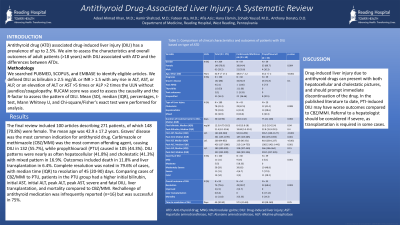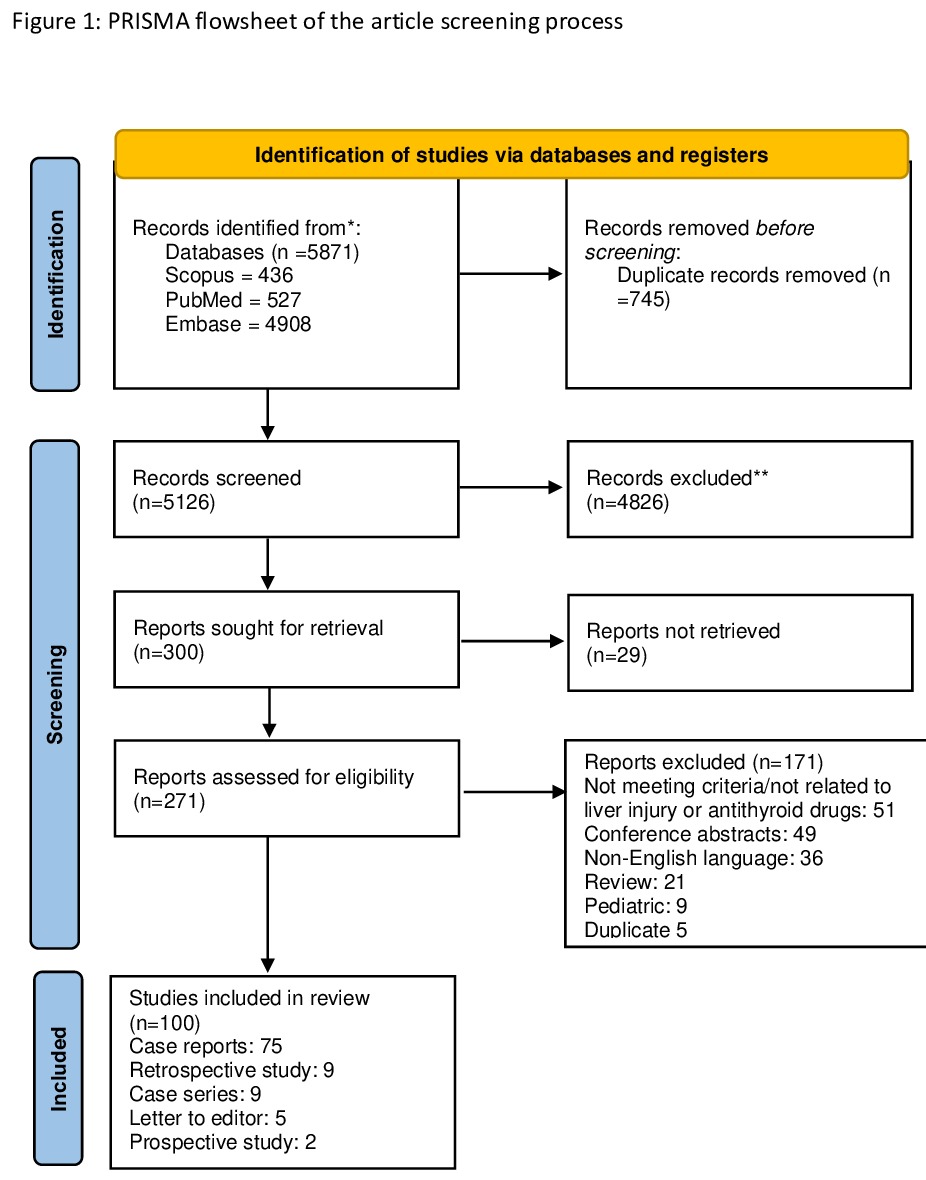Tuesday Poster Session
Category: Liver
P3789 - Antithyroid Drug-Associated Liver Injury: A Systematic Review
Tuesday, October 24, 2023
10:30 AM - 4:00 PM PT
Location: Exhibit Hall

Has Audio
- AS
Aamir Shahzad, MD
Reading Hospital
Reading, Pennsylvania
Presenting Author(s)
Adeel Khan, MD1, Aamir Shahzad, MD2, Fateen Ata, MD1, Afia Aziz, MD1, Hana Elamin, MD3, Zohaib Yousaf, MD2, Anthony Donato, MD2
1Hamad Medical Corporation, Doha, Ar Rayyan, Qatar; 2Reading Hospital, Reading, PA; 3National University, Sudan, Doha, Ar Rayyan, Qatar
Introduction: Antithyroid drug (ATD) associated drug-induced liver injury (DILI) has a prevalence of up to 2.5%. We aim to assess the characteristics and overall outcomes of adult patients ( >18 years) with DILI associated with ATD and the differences between ATDs.
Methods: We searched PUBMED, SCOPUS, and EMBASE to identify eligible articles. We defined DILI as bilirubin ≥ 2.5 mg/dL or INR > 1.5 with any rise in ALT, AST, or ALP, or an elevation of ALT or AST >5 times or ALP >2 times the ULN without jaundice/coagulopathy. RUCAM score was used to assess the causality and the R-factor to assess the pattern of DILI. Mean (SD), median (IQR), percentages, t-test, Mann Whitney U, and Chi-square/Fisher's exact test were performed for analysis.
Results: The final review included 100 articles describing 271 patients, of which 148 (70.8%) were female. The mean age was 42.9 ± 17.2 years. Graves' disease was the most common indication for antithyroid drug. Carbimazole or methimazole (CBZ/MMI) was the most common offending agent, causing DILI in 132 (55.7%), while propylthiouracil (PTU) caused in 105 (44.3%). DILI patterns were nearly as often hepatocellular (41.8%) and cholestatic (41.3%) with mixed pattern in 16.9%. Outcomes included death in 11.8% and liver transplantation in 6.4%. Complete resolution was noted in 79.6% of cases, with median time (IQR) to resolution of 45 (20-90) days. Comparing cases of CBZ/MMI to PTU, patients in the PTU group had a higher initial bilirubin, initial AST, initial ALT, peak ALT, peak AST, severe and fatal DILI, liver transplantation, and mortality compared to CBZ/MMI. Rechallenge of antithyroid medication was infrequently reported (n=16) but was successful in 75%.
Discussion: Drug-induced liver injury due to antithyroid drugs can present with both hepatocellular and cholestatic pictures, and should prompt immediate discontinuation of the drug. In the published literature to date, PTI-induced DILI may have worse outcomes compared to CBZ/MMI. Referral to a hepatologist should be considered if severe, as transplantation is required in some cases.

Disclosures:
Adeel Khan, MD1, Aamir Shahzad, MD2, Fateen Ata, MD1, Afia Aziz, MD1, Hana Elamin, MD3, Zohaib Yousaf, MD2, Anthony Donato, MD2. P3789 - Antithyroid Drug-Associated Liver Injury: A Systematic Review, ACG 2023 Annual Scientific Meeting Abstracts. Vancouver, BC, Canada: American College of Gastroenterology.
1Hamad Medical Corporation, Doha, Ar Rayyan, Qatar; 2Reading Hospital, Reading, PA; 3National University, Sudan, Doha, Ar Rayyan, Qatar
Introduction: Antithyroid drug (ATD) associated drug-induced liver injury (DILI) has a prevalence of up to 2.5%. We aim to assess the characteristics and overall outcomes of adult patients ( >18 years) with DILI associated with ATD and the differences between ATDs.
Methods: We searched PUBMED, SCOPUS, and EMBASE to identify eligible articles. We defined DILI as bilirubin ≥ 2.5 mg/dL or INR > 1.5 with any rise in ALT, AST, or ALP, or an elevation of ALT or AST >5 times or ALP >2 times the ULN without jaundice/coagulopathy. RUCAM score was used to assess the causality and the R-factor to assess the pattern of DILI. Mean (SD), median (IQR), percentages, t-test, Mann Whitney U, and Chi-square/Fisher's exact test were performed for analysis.
Results: The final review included 100 articles describing 271 patients, of which 148 (70.8%) were female. The mean age was 42.9 ± 17.2 years. Graves' disease was the most common indication for antithyroid drug. Carbimazole or methimazole (CBZ/MMI) was the most common offending agent, causing DILI in 132 (55.7%), while propylthiouracil (PTU) caused in 105 (44.3%). DILI patterns were nearly as often hepatocellular (41.8%) and cholestatic (41.3%) with mixed pattern in 16.9%. Outcomes included death in 11.8% and liver transplantation in 6.4%. Complete resolution was noted in 79.6% of cases, with median time (IQR) to resolution of 45 (20-90) days. Comparing cases of CBZ/MMI to PTU, patients in the PTU group had a higher initial bilirubin, initial AST, initial ALT, peak ALT, peak AST, severe and fatal DILI, liver transplantation, and mortality compared to CBZ/MMI. Rechallenge of antithyroid medication was infrequently reported (n=16) but was successful in 75%.
Discussion: Drug-induced liver injury due to antithyroid drugs can present with both hepatocellular and cholestatic pictures, and should prompt immediate discontinuation of the drug. In the published literature to date, PTI-induced DILI may have worse outcomes compared to CBZ/MMI. Referral to a hepatologist should be considered if severe, as transplantation is required in some cases.

Figure: PRISMA Flow Diagram
Disclosures:
Adeel Khan indicated no relevant financial relationships.
Aamir Shahzad indicated no relevant financial relationships.
Fateen Ata indicated no relevant financial relationships.
Afia Aziz indicated no relevant financial relationships.
Hana Elamin indicated no relevant financial relationships.
Zohaib Yousaf indicated no relevant financial relationships.
Anthony Donato indicated no relevant financial relationships.
Adeel Khan, MD1, Aamir Shahzad, MD2, Fateen Ata, MD1, Afia Aziz, MD1, Hana Elamin, MD3, Zohaib Yousaf, MD2, Anthony Donato, MD2. P3789 - Antithyroid Drug-Associated Liver Injury: A Systematic Review, ACG 2023 Annual Scientific Meeting Abstracts. Vancouver, BC, Canada: American College of Gastroenterology.
